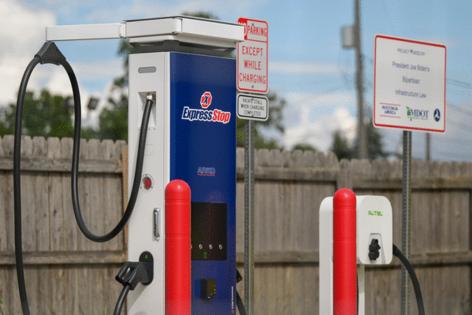Michigan charges forward with federal funding plan for EV network
Published in Automotive News
Michigan's buildout of electric vehicle chargers, its future clouded by a federal funding freeze, is moving forward after receiving approval of a revised plan for spending more than $50 million in remaining funds.
The Michigan Department of Transportation expects next spring to issue another round of requests for proposals to add more DC fast chargers in hopes of encouraging EV adoption. Limited access to charging stations, particularly fast chargers that can add 100 miles of range on some EVs in as little as 10 minutes, is one of the biggest causes of hesitancy and range anxiety for consumers in assessing whether to get an EV.
The U.S. Department of Transportation last week approved the state's revised plan under the National Electric Vehicle Infrastructure Formula Program, paving the way for the release of $52 million remaining from $110 million originally allocated for the program before President Donald Trump's administration froze the funding in February.
"We're still very much moving ahead with the NEVI program, and never stopped," said Steve Minton, who is managing the project for MDOT. "And we're excited to be able to utilize the remaining funding, and work with the industry to get as many chargers out as we can with the funding that we have left, and do it in a strategic way that will benefit the state of Michigan's citizens."
The federal funding pause was for the $5 billion Biden-era NEVI initiative included in the 2021 Bipartisan Infrastructure Law. Republican and Democratic lawmakers both criticized the program after it produced a few completed, functional charging stations within its first three years — becoming a poster child for government inefficiency.
But after a signal that a court could rule against the administration's funding pause, the Federal Highway Administration last month issued revised rules that seek to provide more flexibility to states and reduce red tape. States had to supply their updated agreements within 30 days.
"While I don’t agree with subsidizing green energy, we will respect Congress' will and make sure this program uses federal resources efficiently," Transportation Secretary Sean Duffy said when the new rules were announced.
Michigan's updated fiscal 2026 plan has about 70 fewer chargers than before the revisions, Minton said. In particular, the plan focuses on how the state will use the remaining funds, the kind of community engagement it has done to develop and receive feedback on the plan, and cybersecurity strategies to protect the network.
Much of the information in MDOT's revised plan is from its previous update. The department kept the plans for future use of the funds general, including applications for major routes, community charging, destination charging and future consideration, Minton said.
"There wasn't time," he said, "to really get down to a specific level of detail with how we're going to use every last dollar."
That, however, will be part of the next step. NEVI first requires the buildout of "alternate fuel corridors" along which to place the chargers off highways at locations like gas stations, convenience stores and supermarkets. In Michigan, those corridors include Interstates 75, 96 and 69, U.S. 127 and other major roadways.
The Biden-era rules required that chargers be installed within 50 miles of each other, but the Trump revision allows states to set that distance to whatever they believe is reasonable. MDOT chose 60 miles, though in the Upper Peninsula, the distance is as much as about 80 miles after the department didn't receive a proposal to shrink that spread. MDOT was planning to submit a letter this week to the FHWA certifying that buildout.
"We've got 83 stations," Minton said, "along these AFCs that we feel achieves that buildout status."
Michigan is expected to achieve buildout in the next few years. Trump's funding pause didn't stop reimbursement for already-approved NEVI charger locations in Michigan, though just two sites — in Lansing and Walker outside of Grand Rapids — have been completed so far. They include a total of 10 charging ports. Another four sites are under construction, and Minton said he expects 10 could be completed by the end of the year.
With the fuel corridor charger buildout certified, Michigan would be free to use the charger funds for discretionary projects. That may include more chargers along those corridors, but also could include chargers in local communities, along other major highways like U.S. 23 in northeast Michigan, in population centers like Metro Detroit, Grand Rapids and Lansing and tourism destinations, and for heavy trucking.
MDOT will work on prioritizing those objectives in the coming months in consultation with other relevant agencies and external partners. Minton said he expected that by March or April, the state will issue its next request for proposals for that funding, which will be the largest money pot compared to previous NEVI RFPs. A Michigan State University study that concluded Michigan needs more than 66,600 chargers — estimated to cost $998 million — to support 25% EV market penetration will help inform the plans.
"We had plenty to do with round one and round two, with having 83 sites that we weren't ready to even start the next round," Minton said. "The time it took for them to figure out if they were going to move ahead with NEVI or what they were going to do, it allowed us to continue on. And then when they did finally release the guidance update in August, it was actually really good timing for us."
MDOT gave companies awarded funds in 2023 under NEVI three years to get the chargers up and running. Those awarded in 2024 have two years. The state, however, is still bringing some of those companies under contract with the proper documents, insurance and proof of bonding to be a state and federal contractor.
"That's been a learning curve for the industry," Minton said.
Additionally, electrical components for transformers and switch gears needed to support the buildout of fast chargers can have long lead times. MDOT must obligate its NEVI funds prior to the end of the 2026 fiscal year, but there isn't a federal deadline by when the funds must be used. In addition to the years to design and build out these sites, companies are reimbursed by up to 80% over five years, during which time they commit to operate and maintain the chargers.
Given the pulled and then reinstated funding for NEVI, Minton said there's motivation to secure contracts for the funding, though stopping it likely would require an act by Congress: "I'm not seeing a lot of risk if we take a little time to do some planning. We don't want to just jump into another solicitation. And we've been engaged with our Federal Highway office division, and they're on board with our approach to how we're going to move ahead. We're not going to drag our feet with it."
Mehrnaz Ghamami, an associate professor at MSU's College of Engineering who co-authored the EV charger report, said roadways for intercity travel should be the priority to reduce range anxiety, given that cold weather can reduce battery capacity by 30%.
"Without fueling stations," she said, "a lot of those trips won't be EVs."
Michigan so far has done a good job of filling those gaps, she said, though some remain, especially in the Upper Peninsula. Some areas don't even have gas stations or other locations to install chargers.
With residents in urban areas more likely to adopt EVs, ensuring access to charging stations for those in multi-family housing units would help increase EV use in Michigan, Ghamami added. Support for medium-duty and heavy-duty transportation is also an important next space to address.
The new federal guidance removed an order for states to ensure "the deployment, installation, operation, and use of EV charging infrastructure achieves equitable and fair distribution of benefits and services." It also eliminated a requirement for states to explain how their NEVI implementation would encourage participation from small businesses, including minority-owned and women-owned small businesses. The new requirements also minimized state obligations to consider "electric grid integration and renewable energy."
The revised rules, however, don't prevent states from taking those matters into account, and the research for Michigan's original proposal will continue to inform its plans and priorities as it moves ahead.
"We may not just come out and say it directly," Minton said about ensuring charging in disadvantaged communities, "but we'll still be looking at that very much."
Detroit-based Red-E is a supplier of EV chargers and their software. It’s supplying dozens of NEVI locations in Michigan and more nationally. CEO Abass El-Hage illustrated the difference the funding makes: A regularly used charger in a place like Los Angeles might be able to make up the investment in three to five years without incentives. But in more remote areas, a charger might only see two vehicles per day. The payback could be 10 to 15 years.
“The incentives come in to bridge that gap,” El-Hage said, making the deployment of chargers in rural places possible where it otherwise wouldn’t make financial sense to do so.
One of the biggest concerns in the program's deployment had been the cost for infrastructure to support fast chargers in remote areas — which small utility companies in northern Michigan and the Upper Peninsula were estimating could be millions of dollars in some cases. With the 50-mile requirement gone, that alleviates the risks of Michigan losing out on funding, though it doesn't address the challenge of making EV charging available in those areas as NEVI was intended to support.
Companies like Toronto-based eCamion Inc.'s Jule are helping address those obstacles. The EV charging system supplier includes massive lithium ion battery storage with its system. Doing so helps particularly rural areas avoid costs of upward half-a-million dollars for utility infrastructure upgrades to support direct-from-grid charging, said Joseph Povolo, Jule’s sales and marketing coordinator.
Instead, the system allows the battery storage to charge during off-peak hours at night when electricity use is “next to nothing,” Povolo said. Energy from the battery then charges EVs that visit the ports, typically during the day. The system also lessens the burden on rural electrical grids by charging during off-peak times to lessen the need to increase the electricity generation needed during peak times, such as the afternoon.
“We take whatever spare capacity on the nearest transformer,” Povolo said. “Usually, we don’t need more than 50 kilowatts of spare capacity. If that’s what you have, that’s more than enough.”
The U.S.-built batteries also act as a backup power source in the event of a power outage. Jule has more than 100 ports across roughly 40 locations. There is a pipeline of 60 planned NEVI sites nationally, including at least two in the Upper Peninsula in Quinnesec and Iron Mountain. Another 150 to 200 sites in Canada are expected to come online in the next two to three years.
Povolo declined to provide exact pricing for the system, but it’s at least a quarter of a million dollars for the system alone. Red-E’s system, including installation, is around that.
"That is one option in more rural areas that we support," Minton said. "I imagine we'll have more of that as we move ahead."
©2025 www.detroitnews.com. Visit at detroitnews.com. Distributed by Tribune Content Agency, LLC.








Comments